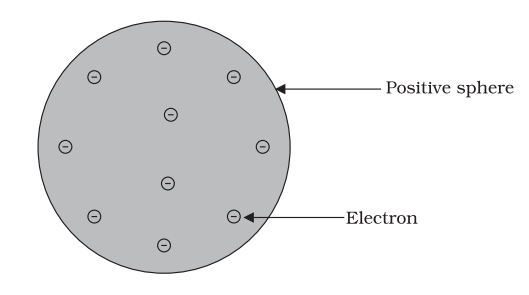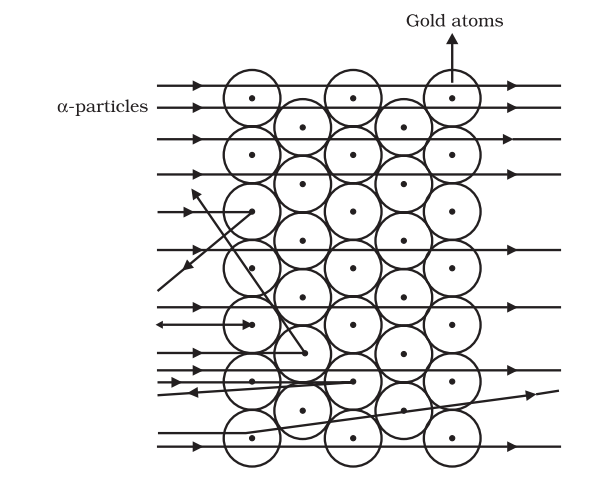Class 9 Structure of the Atom Notes
NotesStructure of the Atom Notes
Sub atomic particles:- Electron , proton and neutron.
- Electron was identified by J.J. Thomson in 1897, proton was identified by E. Goldstein in 1886 and neutron was identified by James Chadwick in 1932.
- The mass of proton is approximately 2000 times as that of the electron.
- The charges of proton (p+) and electron (e–) are equal in magnitude but opposite in nature.
Canal rays: The positively charged radiations produced in the discharge tube from anode are called Canal rays.
Thomson’s model of an atom:-
Thomson compared an atom with a Christmas pudding (We can think of a watermelon). According to him, positive charge in the atom is spread all over like red edible part of watermelon while the electrons are embedded in it like seeds.

Thomson proposed that :-
- An atom consists of a positively charged sphere and the electrons are embedded in it.
- The negative and positive charges are equal in magnitude. So, the atom as a whole is electrically neutral.
Drawbacks of Thomson’s model of an atom:-
- He did not give any experimental support to his model.
- His model could not satisfy the experiments given by other scientists.
Rutherford’s model of an atom:-
Alpha (α) particles scattering experiment:-
Rutherford selected a very thin gold foil which was about 1000 atoms thick. He bombarded it with fast moving α – particles (He2+ ions). This experiment is known as alpha (α) particles scattering experiment.
Observations of α-particles scattering experiment:-
- Most of the fast moving α-particles passed straight through the gold foil.
- Some of the α-particles were deflected by the foil by small angles.
- Very few, that is about one out of every 12000 particles appeared to rebound.

Conclusion of α-particles scattering experiment:-
- Most of the space inside the atom is empty because most of the α-particles passed through the gold foil without getting deflected.
- Very few particles were deflected from their path, indicating that the positive charge of the atom occupies very little space.
- A very small fraction of α-particles were deflected by 180°, indicating that all the positive charge and mass of the gold atom were concentrated in a very small volume within the atom.
Features of Rutherford’s nuclear model of an atom;-
- There is a positively charged centre in an atom called the nucleus. Nearly all the mass of an atom resides in the nucleus.
- The electrons revolve around the nucleus in well-defined orbits.
- The size of the nucleus is very small as compared to the size of the atom.
Drawbacks of Rutherford’s model of the atom:-
Any particle in a circular orbit would undergo acceleration. During acceleration, charged particles would radiate energy. Thus, the revolving electron would lose energy and finally fall into the nucleus. If this were so, the atom should be highly unstable and hence matter would not exist in the form that we know. But, we know that atoms are quite stable.
So, Rutherford could not explain the stability of an atom.
Bohr’s model of atom:-
Postulates of Bohr’s model of atom:-
- Only certain special orbits known as discrete orbits of electrons, are allowed inside the atom.
- While revolving in discrete orbits the electrons do not radiate energy.

Neutron (n):-
- It was discovered by James Chadwick in 1932.
- It has no charge and a mass nearly equal to that of a proton.
- Neutrons are present in the nucleus of all atoms, except hydrogen.
- The mass of an atom is given by the sum of the masses of protons and neutrons present in the nucleus.
Rules for distribution of electrons in different orbits (shells):-
- The maximum number of electrons present in a shell is 2n2, where ‘n’ is the orbit number.
The maximum number of electrons in:- first orbit or K-shell will be = 2 × 12 = 2,
- second orbit or L-shell will be = 2 × 22 = 8,
- third orbit or M-shell will be = 2 × 32 = 18,
- fourth orbit or N-shell will be = 2 × 42 = 32, and so on.
- The maximum number of electrons that can be accommodated in the outermost orbit is 8.
- Electrons are not accommodated in a given shell, unless the inner shells are filled. That is, the shells are filled in a step-wise manner.
Valence electron:-
The number of electrons present in the outermost shell of an atom is called its valence electrons.
Valency:-
The combining capacity of an element is known as its valency.
Atomic number (Z):-
The atomic number is defined as the total number of protons present in the nucleus of an atom.
Atomic number = Number of protons
Mass number (A):-
The mass number is defined as the sum of the total number of protons and neutrons present in the nucleus of an atom.
Mass number = Number of protons + Number of neutrons

Nucleons:- The protons and neutrons present in the nucleus are called nucleons.
Isotopes:-
The atoms of the same element, having the same atomic number but different mass numbers are called isotopes.
Ex:- Hydrogen:- Protium (), deuterium (
or D) and tritium (
or T),
Carbon:- and
,
Chlorine:- and
, etc.
Some applications of isotopes are:-
- An isotope of uranium is used as a fuel in nuclear reactors.
- An isotope of cobalt is used in the treatment of cancer.
- An isotope of iodine is used in the treatment of goitre.
Isobars:-
Atoms of different elements with different atomic numbers, which have the same mass number, are known as isobars.
Ex:- and
.


Comments